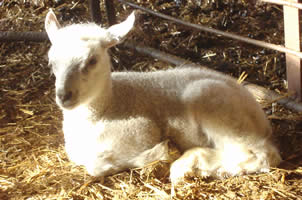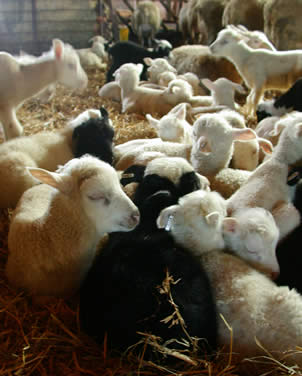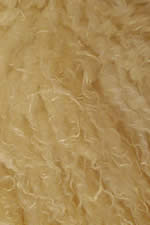
| ASSOCIATION HISTORY PRODUCTION
TRAITS WOOL CONTACT |
|
| |
|
PRODUCTION TRAITS |
|
Characteristics |
 |
| Finnsheep is lively and alert by nature.
Herd instinct is especially strong in this breed; it is emphatically
a gregarious animal.
• Sheep can be found in different colours; white, brown
and black.
• An adult Finnsheep ewe weighs 65 – 75 kg.
• Mature size of an adult Finnsheep ram is 85 – 105
kg.
• Finnsheeps’ head and legs are free from wool. They
can have a small wool formed fringe but no horns. |
| |
|
| |
|
| |
|
1) Reproduction
Finnsheep are widely known for their high prolificacy. Fertility of this
breed excels many other sheep breeds in various ways.
Under fertility qualities are considered:
Early sexual maturity
• Finnsheep ewe lambs can be mated as early as at the
age of 7 – 8 months.
• The only limiting factor is the size of the ewe lamb.
The recommended weight is 50 kg.
• Finnsheep ram lambs will be fertile at the age of four
months.
• Finnsheep rams are very active and have a high libido.
• Weight of their testis compared to their live weight
is greater than in most sheep breeds.
• They have a good ability to serve multiple ewes.
• Semen quality of Finnsheep rams is found to be excellent:
plenty of spermatozoa and good motility.
Capability to lamb out of season
Many of the known sheep breeds are capable to breed only
for about three months during the autumn. It is virtually
impossible to get these breeds to lamb any other time than
in spring.
• The Finnsheep can be lambed in any time of the year.
• The heat is long and it even shows over the lactation
period.
• After weaning Finnsheep ewes come to heat in a shorter
period than other sheep breeds. The time of the weaning has
no effect on this.
High ovulation rate
• Finnsheep ewes shed more eggs.
• Embryo survival rate is good.
Large womb capacity
• Womb of a Finnsheep ewe is capable to withstand the
pregnancy of multiple lambs.
• Creates possibility for full term and vigorous lambs.
Good conception rate
• Only 1–2 % of ewes age two years and over are
left barren, the quantity is smaller than in other sheep breeds.
Frequent lambings
• Finnsheep are capable of lambing more frequently than
once a year.
• Their breeding interval can easily be as short as eight
months. This means two lambings in one year or three lambings
in two years.
• All year round fat lamb production is achieved with
this production characteristic.
Large lamb crop
Only some sheep breeds can produce in average over two lambs
per one lambing.
• Finnsheep ewe has in average three lambs per each lambing.
In the first lambing 1,9 lambs per ewe, in the later lambings
2,7 lambs in average.
• Finnsheep ewes produce single lambs in 10 % of the lambings,
twins and triplets both 40 %, quadruplets 10 % and quintuplets
in 2 % of the lambings.
• The number of lambs produced will increase up till the
ewe is five year’s of age.
• Finnsheep ewe’s maintenance cost compared to the
amount of produced lamb meat is lower because
1) The ewe will start to produce already in one year’s
of age.
2) One ewe can produce multiple lambs.
3) Lifetime production is high due to the longevity of Finnsheep
ewes.
• The large lamb crop also enables the efficient follow-up
of the hereditary progress in the different wanted areas.
Mothering ability
• Finnsheep ewe’s hip structure is advantageous
for lambing. It has a rather wide hip.
• Finnsheep ewe’s good ability to lamb and rise
up her offspring has a great implication on the survival of
the lambs.
• Mothering ability of Finnsheep ewes has been found out
to be good in many different studies.
• Finnsheep ewes can produce ample amount of milk. |


 |
| |
|
| |
|
| |
|
2) Meat
production qualities
• Finnsheep can be successfully raised with different farming systems, from
intensive to organic production.
• A Finnsheep lamb can be fed with high cereal diet because it does not
fatten as fast as the other sheep breeds.
• In intensive farming systems and with high cereal diet it is possible
to have 350 g daily gain in which slaughter maturity will be reached 5,5 months.
Carcass weight will be then 25,0 kg and carcass classification at O 2 (EUROP-grading).
• In Finnsheep lamb field management is utilized Finnsheep’s good
ability to use roughage, ability to graze in different kind of environments and
profitability. In lamb grazing attention is paid on the natural behaviour of
animals and in animal welfare.
• The average daily gain is 211 g/d, carcass weight 18,0 kg and carcass
classification O 2 (National Sheep Production results according to Finnish Sheep
recording scheme from year 2005).
• Finnsheep retain fat within the body, around the internal organs, not
between the muscle cells. The meat does not marble. Excess fat can be easily
removed.
• The possibility of fresh lamb meat production throughout the year can
be achieved with Finnsheep based lamb meat production.
Quality features of Finnsheep lamb meat
Finnsheep lamb meat is
• very low in fat, lean
• mild flavoured
• fine textured
• tender
• can be produced as fresh meat all year round |
 |
| |
|
| |
|
| |
|
3) Finnsheep
fur production qualities
• Sheep fur is always a by-product from lamb meat production.
• The production is based on home grown roughage.
• The best quality fur is collected at the same time as the animal is slaughter
mature, before the neck skin is thickened.
• The skin is one layered, there is no wool root between the layers: Easy
leather dressing, can be thinned out more, the hairs stay better in the skin.
• Most of the Finnsheep’s hair curl types produce beautiful fur.
The quality characteristics of Finnsheep fur
• excellent lustre
• beautiful curl
• silkiness of the hair
• numerous Finnsheep’s natural colour possibilities
• soft, light in weight, dense and durable |
  |
| |
|
| |
|
| |
|
4) Finnsheep
as landscape managers
• Finnsheep can be used in different kind of field and environment management
projects with excellent results. They are exceptional foragers.
• Finnsheep eat willingly leaves and thin, tasty shoots from various trees
and bushes. Finnsheeps’ utilization of roughage is good; they clear out
bushes and undergrowth from the woods with great effectiveness.
• Finnsheep graze with greater effectiveness in various wild, natural and
unmanaged grazing lands than the heavier breeds.
• When using Finnsheep as environment managers’ can be utilized both;
the maintaining and care of the variation of biodiversity and the conserving
of the landraces. Landscapes of traditional origins are recommended to be managed
with landraces.
• Finnsheep can be also used as treatment supporting animal in different
kind of therapies. |
 |
| |
|
| |
| |
|
Literature sited: |
|
| Maijala, K., 1968. |
Suomenlammas kiinnostaa ulkomaisia asiantuntijoita.
Pellervo 69: 704-7. |
| Maijala, K., 1968. |
Montako karitsaa uuhelle? Pellervo 69: 768-769. |
| Maijala, K., 1968. |
Lampaamme erikoisominaisuuksien hyväksikäyttö.
Pellervo 69: 962-963. |
| Maijala, K., 1976. |
Suomenlammas meillä ja muualla. MT. 26.8.1976. |
| Maijala, K., 1984. |
Lammas on monikäyttöinen. MT yliö. 21.7.1984. |
| Maijala, K., 1985. |
Lammastalouden tuotantomallit. Suom. Maataloustiet.
Seur. Tiedote. 6: 118-128. |
| Maijala, K., 1985. |
Lammastalous ja suomenlammas. Suomen Kotiteoll. Museon
julk. 1985: 4-9. |
| Maijala, K., 1996. |
Suomenlampaasta hyviä kokemuksia monissa maanosissa.
MT yliö. 11.6.1996. |
| Maijala, K. et al.1997. |
Lammastalouden turvaaminen ja kehittäminen EU-oloissa.
MT yliö. 10.4.1997. |
| |
| International literature sited: |
| Fahmy, M.H. (ed.), 1997: |
Profilic Sheep. 542 pp. CAB International, Wallingford,
Oxon OX10 8DE, UK. |
| Piper, L.P. & Ruvinsky, A. (ed.), 1997: |
The genetics of Sheep. 611 pp. CAB International, Wallingford,
Oxon OX10 8DE, UK. |
| Shehata, E.I. (ed.), 1996: |
Symposium on Use of Exotic Breeds in Improving Sheep
Production. Finnsheep as case study. 160 pp. Egypt, Apr.
22-23, 1996. Organized by Sheep & Goat’s Research
Dept., Anim. Prod. Research Inst., Agricultural Research
Centre, Ministry of Agriculture, Egypt and Institute of
Animal Production, Agric. Res. Centre of Finland, Sponsored
by FINNIDA. |
|
| |
|
| www.finnsheep.fi © Finnsheep r.y.
r.f |
|
|
|
